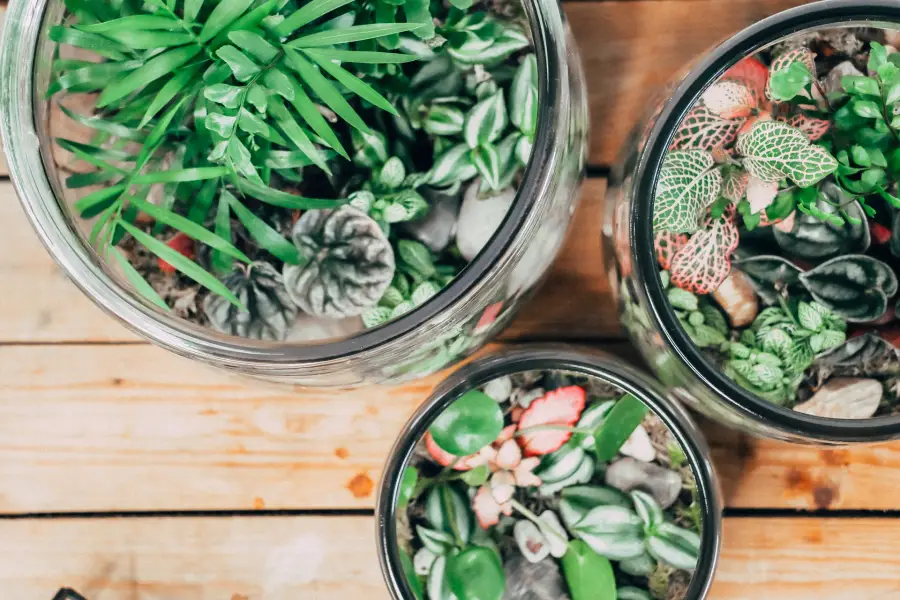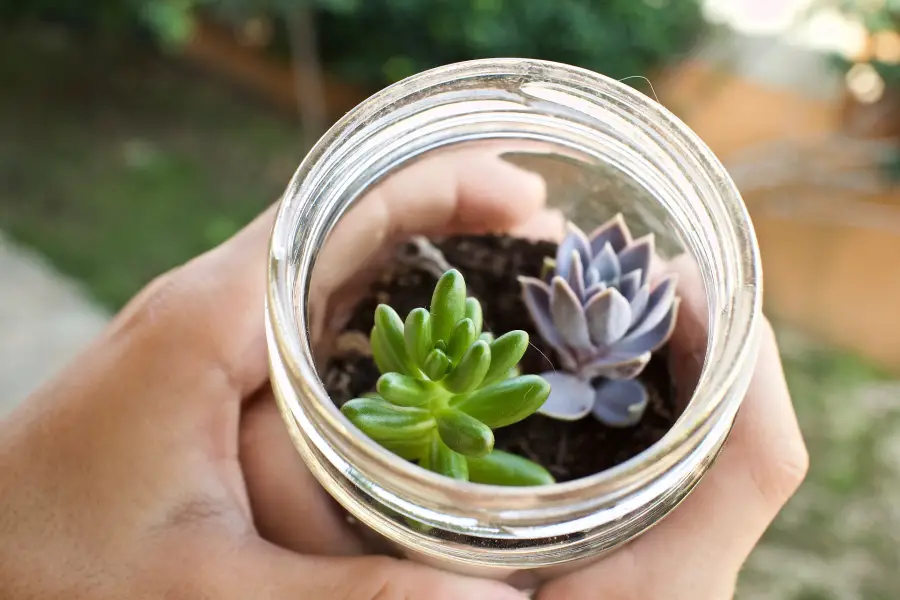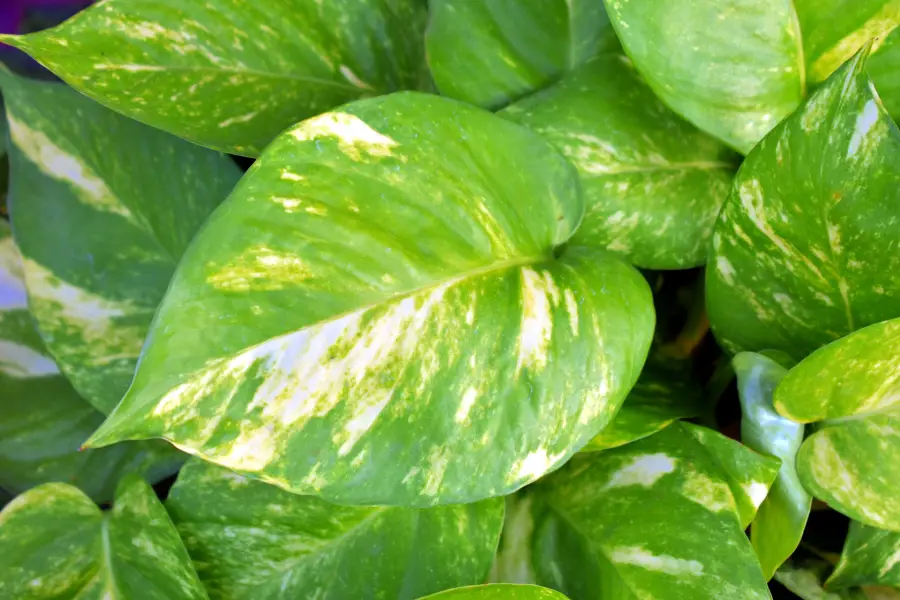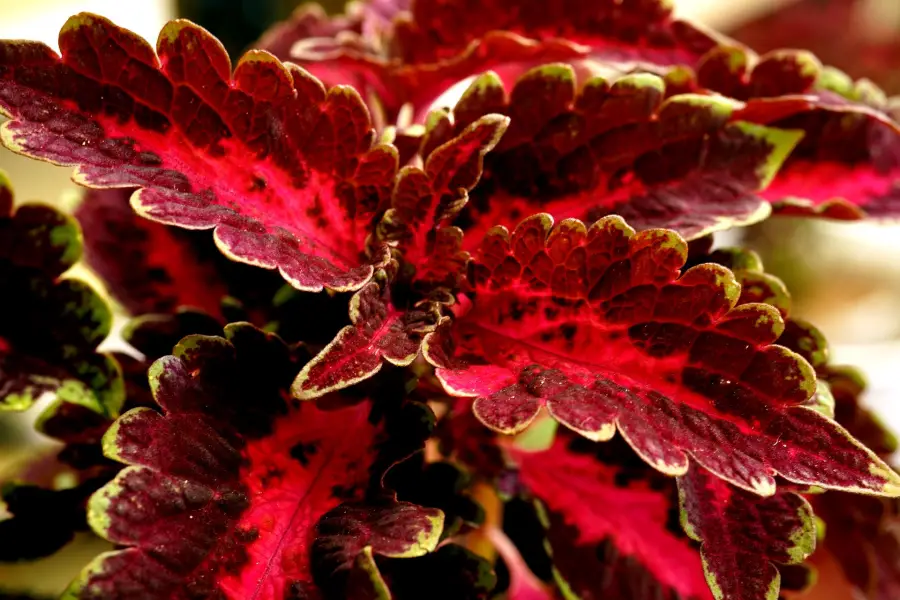Potted plants are always a nice touch in your yard or indoors. Ceramic pots are the classic choice but is glass also an option?
You can easily grow plants in glass whether it is in jars, bottles, fish bowls or other containers. The type of plant you choose can determine success and proper setup is necessary. A glass container is by nature more fragile than other options so size of the plant and root systems are a concern.
That is what we look to answer today as we explore the possibility of growing plants in glass containers. We will start by looking at the best plants for this before we take you through a step-by-step guide to the whole process.

Contents
Why Would You Want To Grow Plants In Glass Containers?
Glass containers can grow smaller plants with less invasive roots systems well. These containers also offer a unique look that can compliment many areas of someone’s home. Though some of these can do well in outdoor environments for part of the year, they mainly are seen inside.
Bottles, jars, and other glass containers are used both for their stylish additions to a home’s decor and for their inexpensive reuse of ordinary items. If done properly they can be inexpensive, low maintenance, and used as a part of kitchens, bathrooms, or even window sills all around the house.
There are many uses that glass containers can fill, but as a sylish or useful home to your houseplants, they can shine. Let’s look at a few of the reasons some choose them in their indoor environments.
Indoor Herb Gardens
Herbs are used in a large percentage of cooking and freshly grown specimens are either expensive or hard to come by. The solution is to grow them yourself in your own kitchen.
Due to the nature of outdoor environments, weather can be both a help and hinderance to establishing and maintaining your herbs. Growing them indoors in a location with ample light can be just the solution.
In or near kitchen windows are great locations for supporting many varieties of herbs. To give a sleek and clean look to your plants, glass containers can be just the ticket.
Here is a rustic way I recommend to use mason jars able to be placed in most window ledges or on counters found on Amazon.
With a good pebble base to keep pooling water away from the roots and periodic repotting, you can grow most of the herbs you will need.
Terrariums
There are more uses for fish bowls and aquariums than some may imagine. Some even use full aquariums with no fish included for underwater plantscapes. Others use dry or semi-dry fish bowls to develop succulent or cactus displays.
Sometimes you can even include small animals or fish in them as well. The variations are endless.
You can even add light sources made for plant growth and use these living works of art in any area of your home or office space.
Glass Containers Are Suited To Easier Care Plants
Plants like succulents and cacti are perfectly suited for glass containers of all kinds. These specific variations need less water, less soil, and there are even versions of succulents that can grow in nothing but water!
This is also a good way for beginners in the area of houseplants to get a clear view of the soil underneath in order to water and care for the plant correctly. With decorative pebbles and the right soil, it can even be a beautiful part of the display in itself.
Many plants also grow to only small sizes and don’t propagate themselves as much as others. Cacti and succulents tend to be in this category. Though some succulents can grow larger and spread more, in general they are more manageable than other plants for this use.
Jars And Bottles Are Readily Available
There are many jars and bottles that we use every day that can be used for just this purpose. Everything from vases to spaghetti sauce jars make great homes for indoor plants.
Some others are…
- fish bowels
- drinking glasses
- beakers
- vases
- mugs
- food jars
- soup bowls
There are many types of jars and bottles that can be used. The only limitation will be the accessibility or size of the opening. If you are handy or crafty, you can even modify the opening, but due to the danger of breakage and injuries, be sure to use protective gloves and eyeware.
Generally, modification will not be necessary. There are a tremendous amount of options when deciding on which glass container to use.
Plant Cuttings Are Rooted In Water Filled Glass Jars
Many know of how to take cuttings from a plant and place them in water to encourage roots to form. There are additives to the water that you can use to help the process along.
One essential ingredient in the procedure is a glass container. This allows you to monitor the progress without having to disturb the plants. Some even use large containers like fish bowls or tanks for some spectacular root system development.
This does not work on all types of plants, but there is a long list of those that can be started in this way. Here are some of the easier varieties…
- Coleus
- Swedish ivy
- Croton
- Papyrus
- Zebrina Pendula
- Succulents (Most Varieties)
- Spider Plants
- Pothos
- African Violet
- English Ivy
What Plants Grow Well In Glass Jars?
Naturally, before we start growing plants in any form of container, we must consider the question of suitability.
What are the watering needs?
How big and deep do the roots get?
As with all plants, roots systems, watering needs, and sunlight levels determine which plants grow well in glass or other containers. For glass jars or bottles ferns, succulents, or cacti all make good options. There are also variations of these that can work just as well.
All of these considerations are essential when you’re planning on using glass. As you know, glass can be very brittle. It must not be subjected to high levels of pressure because it may eventually break. This is why you should only use plants that don’t grow too big or young plants that will eventually be replanted elsewhere.
If done correctly, the use of glass containers can provide plants with great health benefits. Plants potted in this way can also boost the aesthetic appeal of living and working spaces.
Here is a great option I recommend using beakers with a wood frame found on Amazon.
So, what plants will work well with glass?
Types Of Plants That Grow Well In Glass
Lets take a more in depth look at what types of plants can be grown in glass.
Ferns In Glass
Ferns, for starters, are always a safe bet. They have very shallow root systems which require very little watering. Also, ferns do not need loads of sunlight, which makes them an awesome indoor choice. Maidenhair fern and House Holly fern are particular favorites of ours.
Succulents In Jars

Succulents are also a good choice for glass containers, jars, and bottles. Colorful varieties such as California Sunset, chalk sticks, Red Aloe, Sunset Jade, Coppertone Stonecrop, etc. are just a few ways to add some real color and pizzaz to your yard or indoor spaces.
These are great for all around the house as long as some natural light or specific lighting is available. The variety of colors and shapes can even compliment living rooms and bedrooms.
Cacti In Glass Containers
Certain members of the cacti family can be planted in glass containers too. As you know, these plants have adapted to survive in harsh desert conditions, which means that you don’t have to water them as much. We recommend small types like Bishop’s Cap and Angel’s Wings.
These, like succulents, can be placed all around your home to add some color. Though they are great in a kitchen as well, they can be a good addition to most any room.
Ivy Or Vines In Glass
Ivy plants are another great choice. These plants are comfortable in jars containing water or soil, provided they get adequate sunlight. English Ivy is a standout choice for glass containers.
These are some of the most beginner friendly types of plants that are ‘hard to kill’. Though they can definitely be mistreated, it only takes minimal effort to make them thrive.
These also are great additions to high perches like bookshelves or ledges. They will drape over edges to create a dramatic look.
Wandering Jew In Glass Vases
You could also try out Wandering Jew, which has many aesthetically pleasing varieties. From Tradescantia blossfeldiana to Tradescantia fluminensis, you are spoilt for choice. Tradescantia species are highly adaptable and can be grown in water, soil, or a combination of both. We recommend these species for both indoor and outdoor decoration.
The interesting color combinations that these little plants sport adds a lot to any decor. Their versatility also makes them an excellent choice for the beginner glass container plant enthusiast.
To read some other great articles along the same lines, I recommend my others…
Pothos

Pothos is also an option, especially for busy people who tend to forget about plant care. Much like cacti, pothos plants are very low maintenance once set up. Simply set them in a mason jar with water and position them in a well-lit area.
Sometimes people also call it the ‘money plant’ due to its coloration and even ease of care. It tends to thrive and multiply with minimal effort.
Wheatgrass
A mason jar with rich soil is also a good home for wheatgrass. All you have to do is plant some wheatgrass seeds, water periodically, and you’re all set. Wheatgrass requires damp and shady conditions so take heed.
Many extol the benefits of wheatgrass and usually use it in powder form. You can grow your own or get a bag all ready to use like this one on Amazon.
Purple Oxalis In Glass

Purple Oxalis is another gem. This plant is absolutely perfect for your windowsill, where it can get the sunlight it needs to add color to your environment.
Aloe Vera (In The Beginning)
Don’t make the mistake of thinking that glass containers can only serve aesthetic plants. Aloe Vera, for example, can just as easily be grown in a glass jar. Renowned for its many health and nutritional benefits, Aloe Vera is always a good thing to have on hand.
Unfortunately, though, you will have to replant it outside or in a bigger pot when it starts to outgrow the container. Though keeping a smaller plant inside for use on slight burns and skin irritations can be a great alternative to running to the drugstore for expensive ointments.
Snake Plant
Snake Plant is another beneficial option, particularly for indoor spaces. Not only does it produce high levels of oxygen during respiration, but it also works as a biological air filter. Snake Plants can rid your air of xylene, formaldehyde, benzene, and, of course, carbon dioxide.
Many Common Herbs Do Well In Glass Containers
Lastly, we have the classic kitchen herbs, which can all be grown in jars with soil and access to rich sunlight. Cilantro, thyme, mint, parsley, basil, you name it. All perfectly suited to life in a glass container.
How Do You Grow Plants In A Glass Container?
Growing plants in glass containers is a pretty straightforward process, as you shall soon see.
Step 1: Choose Your Glass Container
The first step is to identify your plants of choice, as well as the container(s) you will use. You can either use a “one plant per container” approach or a biodiverse terrarium. The latter approach will require you to use plants with shared growth requirements (soil conditions, watering frequency, sunlight needs) otherwise it won’t work.
Plants that need a lot of water, such as lilies, must not be placed in the same terrarium as desert-resistant plants like cacti.
As for the containers, we recommend large transparent mason jars, vases, bottles, or vacant fishbowls. An empty fish tank is an excellent choice for a rich and varied terrarium. Glass containers can be repurposed milk containers or jam jars.
Local craft stores have plenty of glass containers you could use. We recommend that you opt for containers with large openings unless you want to be using tweezers to access the plants. However, keep in mind that the wider the opening, the quicker the rate of evaporation…which means you will have to water more frequently.
Step 2: Horticultural Grit
Once you’ve chosen your plants and containers, you’re all set to begin adding horticultural grit. Add about 2 inches (height) of grit and mix in some pebbles for drainage. The pebbles will reduce the risk of water pooling around the roots, which can lead to rot.
Step 3: Soil
Once the grit is in place, you will have to add potting soil. Loose soil is best for plants that require quick drainage. Tighter soils are ideal for moisture-loving plants. Keep adding soil until the container is about a third of the way full, breaking up any clumps to improve aeration.
Step 4: Add Plants
Next, you will have to plant. You can either plant seeds or established plants.
For established plants, look for signs of deformity, disease, or pests. Brush the roots to eliminate clumping and trim excess leaves and flowers that may hinder the fit.
The next step is to place the plants in the container. Use your hands or a digging stick to form small holes for the plant to sit in. Once the plant is in position, cover the roots with dirt. Try not to let plant leaves rest on the inner sides of the container as these can lead to moisture-induced rotting. Pat down the soil around your plants for added stability.
Step 5: Water
The next step is the initial watering. Using a watering can, pour a little water into the container until it runs down the sides of the dirt and grit. Avoid pouring directly onto the base of the plants otherwise, you may destabilize them and unearth some roots.
At this point, you’re all set to position the container where you see fit. You can also add a few decorative elements and ornaments.
Step 6: Maintain Your New Plant In Glass
The next step is to maintain the plant and container. This involves frequent watering, pruning, and repositioning. Glass allows you to see when the soil is dry, which will make it easier to remember to water your plants.
Also be on the lookout for pests, diseases, and fungi. Mold, for example, may occur in plants that are in an overly humid container. Such occurrences may require you to use a different container.
Alternative Method

Like stated above, some plants are great in just water alone. You can simply add clean, room temperature water and set your plant on top. Make sure to choose the proper one for this application and you may be surprised how easy they are to maintain.
Other than aquatic only plants that you may find in a fish aquarium, here is a short list of some of the best plants that can live solely in water alone…
- Philodendron
- Lucky Bamboo
- Pothos
- Chinese Evergreen & Dumbcane
- Spider Plant
- Arrowhead Plant
- Coleus
These can be an easy way to add color to your home. Let’s look at this option a little closer.
Can Some Plants Live In Glass Jars With Only Water?
There are some situations where you can add aquatic plants with semi aquatic plants to form a unique glass vase display. Many aquarium lovers know that there are some great options for underwater and floating plants.
Adding aquatic grasses to the bottom of a large vase or goldfish bowl gives a great aspect to floating vines or flowering plants resting on top.
There are many plants that can be rooted by placing clippings in glass jars until they are ready to be replanted in their own soil.
The uses for glass containers is varied, but success is determined ultimately by the type of plant used and the maintenance schedule maintained.
The Final Touches On Growing Plants In Glass…
Glass containers plants are a fun option for interior and exterior plants alike. They can be decorative with vines or flowering options, or utilitarian with herbs used for cooking.
Choose from one of the plants above and start a small glass container plant collection yourself to see where your interests lie. It is a great hobby for anyone.
Take a look at some of these other articles you may enjoy…
- Raised Garden Beds Next To House Foundations- Explained
- Which Side Of Your House Gets The Most Sun? (Garden Tips)
- A Manual Weed Wacker: Is There A Such Thing?
References
https://balconygardenweb.com/indoor-plants-you-can-grow-in-jars-and-bottles/
